
Table of contents:
- Author Bailey Albertson [email protected].
- Public 2023-12-17 12:53.
- Last modified 2025-01-23 12:41.
How to fix the error "Your connection is not secure" in Mozilla Firefox

During its existence - since 2002 - the Mozilla Firefox browser has gone through an enviable path of improvement. But new features and functions are not all: it is important that sites do not pose a threat to the personal data of an Internet user.
Content
- 1 What does Firefox mean "Your connection is not secure" error
-
2 How to fix Firefox secure communication problem
- 2.1 Rearranging the system time
-
2.2 Optimization of anti-virus programs
- 2.2.1 Managing antivirus from Windows Task Manager
- 2.2.2 Video: disabling antivirus using Windows Defender as an example
- 2.2.3 Disabling autostart of the antivirus from the settings of the application itself
-
2.3 Check Windows for errors
2.3.1 Checking the registry for errors using CCleanerPro
- 2.4 Clearing Firefox Certificates folder
- 2.5 Windows Update
- 2.6 Opening sites in private browsing mode
- 2.7 Change proxy server settings in Firefox
-
2.8 Adding Security Exceptions to Firefox
2.8.1 Video: How to fix the "Your connection is not secure" error in Firefox
What does Firefox mean "Your connection is not secure" error
Security requirements for websites are very high today. Every self-respecting site owner will take care of the site certificate - the program code by which the site is considered trusted (and reliable), and the site is verified.
Mozilla Firefox, like any browser, warns that a site whose authenticity could not be verified should not be 100% trusted, and blocks the transition of users to its address.

Unable to open page: untrusted site
Sites with which it was not possible to establish a secure session can attack your PC for personal data (logins and passwords to them, debit / credit cards, etc.).
How to fix Firefox secure communication problem
For Firefox to successfully display content on a secure site, a number of conditions must be met. Failure to comply with any of these conditions may prevent the user from entering the site.
Rearranging the system time
Web site security certification is temporary. No security certificate will work forever (while the site is "alive") - it has its own validity period. For example, if the certification rules on the website were configured on 2017-21-12, and your system time was reset to 2012-01-01, the browser may not allow you to visit the site, referring to non-existent certificates.
When a notification about an insecure connection appears, it will be necessary to set the clock to the correct time - for example, if the readings were reset after replacing the battery of the CMOS memory chip in the PC.
In Windows 8.1 and 10, the time is adjusted as follows:
-
Right-click on "Start" and select "Settings" from the contextual main menu.

Entering the system parameters through the context main menu Go to Windows 10 main settings
-
Enter the Time and Language section.

Go to system time and language settings Enter the Windows 10 language and system clock settings
-
Enable the option to automatically set the system time.

Setting the time over the Internet in Windows 10 Turn on autosetting PC time over the network
Your time will be corrected to the reference local time on the Internet. If the synchronization does not take place according to local time, turn off its autoset again, click the "Change" button and select your time zone.
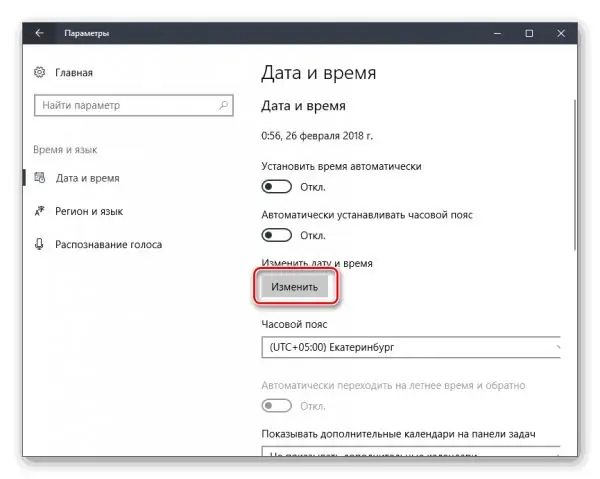
Pick the correct time manually
In Windows 7, the correct time is configured a little differently:
-
Go to the command "Start - Control Panel", enable (if the Windows software toolkit is displayed by category) the view of large / small icons and select the tool "Date and Time".

Choosing to set the date and time in Windows 7 Enter PC date and time management
-
On the Date and Time tab, click the Change Date and Time button.

Go to change date and time in Windows Press the button to change date and time
-
In the Windows calendar, check that the date is correct and enter values in hours and minutes (if the clock is slightly behind or the values have been reset).

How to manually adjust the date and time in Windows Check if the date and time is correct
- Click OK to close all dialog boxes and restart Windows.
After checking the system clock and calendar readings, refresh the page of the site reporting the unsecured connection in Firefox.
Optimization of anti-virus programs
Often, antivirus software reinsures itself - it prohibits the browser from connecting to websites whose security settings violate at least one of the numerous and very serious rules that prevent theft of users' personal data. That is why the antivirus needs to be paused - at least for the time it usually takes to browse a suspicious site.
A number of antiviruses check secure connections within the framework of SSL encryption, while blocking not entirely reliable connections, although they are protected at the level of Internet protocols.
Most antivirus programs are set to auto-start when Windows starts by default. This is necessary to quickly detect and block malicious codes received from the Internet.
Controlling antivirus from Windows Task Manager
"Windows Task Manager" allows you to urgently stop the work of any currently interfering program.
First, close your antivirus program. The easiest way to do this is through the "Windows Task Manager" - often there is no button or option "Unload antivirus" in the program interface of the application itself.
-
Bring up the Task Manager with the keyboard shortcut Ctrl + Alt + Del (or Ctrl + Shift + Esc).

Windows 7 Task Manager Windows Task Manager is ready for your next action
- Go to the Processes tab and find the process your anti-virus program is executing. For the Kaspersky application package, these are the process KAV.exe (Kaspersky AntiVirus), KIS.exe (Kaspersky Internet Security), kaspersky.exe and several similar headers. For Avast, this is usually Avast.exe (the process name may differ). NOD32 in older versions issued the headers "nod32.exe", "enod.exe", "esetgui.exe", the latest versions are signed as "egui.exe".
- Give the command: right-click on the name of the required process - "End the process tree". The antivirus application will close.
Some antiviruses can block the close command - Windows will report this, for example: “Unable to close the program (or process). Access denied.
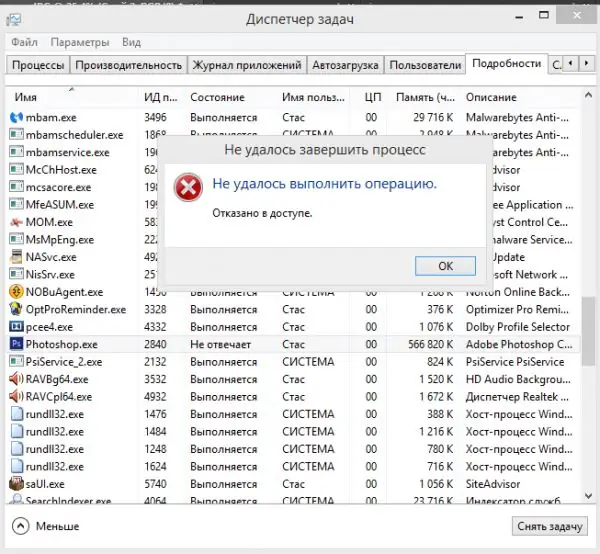
Denying access to close the program using Windows
Video: disabling antivirus using Windows Defender as an example
Disable autostart of the antivirus from the settings of the application itself
If the antivirus could not be stopped, disabling the autostart of the antivirus application itself will help.
In Kaspersky Anti-Virus 2012 (the application regularly receives updates), the function of launching antivirus services is as follows:
-
In the main window of the Kaspersky Anti-Virus application, click the settings button.

Kaspersky Anti-Virus: entering general settings Click the antivirus settings button
-
Issue the command "Protection Center - Basic settings" and uncheck the "Start Kaspersky Anti-Virus at computer startup" box.

Disable AK autostart in general settings Uncheck AK autostart box
- Click OK (or Apply if present) and restart Windows.
Autostart of any other anti-virus program is disabled in the same way.
Check Windows for errors
Windows errors are corruption of program and system files by viruses, errors in the OS registry and on the PC disk, incorrect protocol and network settings in Firefox, and similar problems. Any of these issues can cause Firefox to refuse a user's visit to the site.
Checking the registry for errors with CCleanerPro
The Firefox browser, like any other program, writes its own settings and some information about sessions not only to service files in the program and user folders on the C: drive, but also to the Windows registry.
The CCleaner utility is a worthwhile solution for keeping the Windows registry up and running. You can use both a paid licensed copy of the program and the version already purchased and activated by other users.
-
Download, install and run CCleaner, go to the "Registry" section.

The main toolkit of the CCleaner application To scan the Windows registry, open the section of the same name
-
Click the Troubleshoot button. CCleaner Pro will find errors in the OS registry.

Check Windows registry for errors Click the search error button to start a registry scan
-
Click the Fix Selected button after the check is complete.

Selecting erroneous registry entries in CCleaner Pro Click the fix button after the error list is displayed
-
Confirm the request to save the registry entries to be corrected.

Backing up editable registry entries in CCleaner Confirm saving Windows registry entries
-
Click the Fix Selected button. The CCleaner application, issuing one extra request, this hints that careless intervention in the registry is sometimes fraught with a forced reinstallation of Windows.

Another CCleaner request to fix registry entries CCleaner warns that cleaning the registry is a critical step
The selected OS registry errors will be fixed. Restart Windows after the check is complete and refresh the page of the site, the transition to which was blocked.
Clearing Firefox certificates folder
Site certificates are stored in a separate folder C: / Users / / AppData / Roaming / Mozilla / Firefox / Profiles (if the application was installed in the C: / Program Files folder). Firefox stores all security certificates in the database (*.db files). This helps him to quickly find the required certificate - and check with him when entering a specific site.
As a result of frequent installation of new programs, hidden actions by malware, etc., the files containing Firefox certificates for the sites that are opened can be modified to harm the browser. To remove these corrupted files, do the following.
-
Go to Firefox using the "Menu - Help" command.

Open the Firefox Help Submenu Select the help item from the main browser menu
-
Select "Information for problem solving" in the submenu that opens.

Entering the Firefox Current Issues Information Panel Select the Firefox Help submenu info item
-
In the column of information about the Firefox user folder, click on the button (or link, depending on the version of the browser) "Open folder". Windows Explorer will open this folder in a separate window.

Navigate to the Firefox user profile folder Click on this item to have Windows Explorer open the user folder
- Close your browser. Delete the database file "cert8.db".
When you reopen the browser, the "cert8.db" database will be recreated. Go back to the problem site, where the transition to any of its pages was blocked.
Windows Update
The reason for the error is a really old operating system Windows - 2000 / XP / Vista. Most modern web technologies increasingly require updating the version of not only the browser, but also the OS itself. For the latest versions of Firefox to work, you need at least a build of Windows 7 with SP1.
As an example, updating Windows 10 using Windows Update. This component is built into the system and has its own background service - by default, the OS is configured to receive automatic updates.
If the Windows update did not "arrive" on your PC, and you still need to get uninterrupted access to sites with Firefox, despite following the previous instructions, then do the following:
-
Go to the "Start - Settings" command.

Go to Windows 10 Global Settings Select Windows Options from the main menu
-
Open the Update & Security submenu.

Entering Windows 10 update and protection settings Select the sub-item updates and OS security
-
Go to Windows Update.

Go to Windows 10 Update Select Windows update sub-item
-
In the column "Update status" click the "Check for updates" button.

Checking for Windows 10 updates Wait for new Windows 10 updates to start downloading
Windows will download and install the updates and restart the PC during installation. Upon completion of the process, go back to the problem site.
Opening sites in private browsing mode
In private mode, the history of site navigation, user logins and passwords, exclusion of site certificates during a secure connection, etc. is not saved. To open the problem site, use the "Menu - New private window" command.
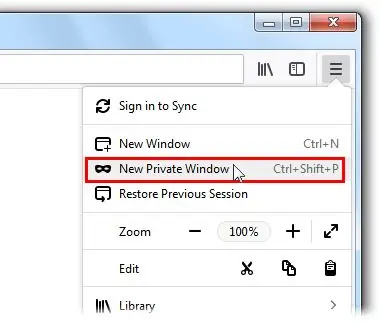
Choose to open a new private window
Or give the command: right click on the link (any site you are directed to from this page) - "Open the link in a new private window".

Choose to browse the new page in Firefox Private Mode
If, nevertheless, the private mode did not save you from a repetitive error, it’s time to change the Internet connection settings, for example, change or disable the proxy server used.
Change proxy settings in Firefox
Certain proxy servers are used mainly to bypass restrictions on access to sites that are closed for visiting both at the federal level and within the local network of an enterprise / institution.
Another function of a proxy is to filter out ads that appear in abundance on almost every site. Such, for example, is the ad blocker included in the HandyCache virtual proxy server.
However, sometimes it is necessary to connect to a site without unnecessary intermediaries, which, in fact, are proxy servers. To disable the proxy server, do the following:
-
Go to the "Menu - Settings" command.

Go to general Firefox settings Enter the main browser settings
-
In the main browser settings, find the "Proxy server" column and click the "Configure" button.

Go to proxy setup in Firefox Click the go to proxy settings button
-
Select the "No proxy" option (if the proxy system settings were used or the user previously specified a specific IP).

Disable proxy server in Firefox Enable direct connections to sites (no proxy)
- Click the "OK" button and refresh the page of the problem site, with which a secure connection has not been established.
Adding security exclusions in Firefox
Bypassing Firefox blocking isn't just about assigning another proxy or encrypting the VPN. Firefox has a standard unblocker for sites that are blocked from viewing by security settings in the browser itself. It is based on the substitution of a certificate that does not comply with the security rules "hardcoded" in Firefox.
-
To "reach out" for a site that has not yet been opened, click the "Advanced" button.

Go to bypass site blocking directly in Firefox Click the Firefox Advanced Options button
-
Under the information about the "incorrect" site security certificate, click the "Add an exception" button.

Add a secure site certification exception in Firefox Open the functionality for adding security exclusions
-
Make sure the "Keep this exception persistently" checkbox is selected and click the "Confirm Security Exception" button.

Request to save a site security exception in Firefox Confirm the site certification security exception
- Refresh the problem site page. Most likely, this will solve the problem of showing blocked website content.
You can also renew the site certificate by clicking the Get Certificate button. If it was not possible to renew the certificate, use the Firefox restriction bypass.
Video: How to fix "Your connection is not secure" error in Firefox
It is not a problem to open a site that has been working for many months (or years) until now - and today the browser has blocked it for user safety. Firefox, like any browser, recommends staying away from suspicious sites - but it can't stop you from visiting them. Nevertheless, great web surfing for you - and fewer problems!
Recommended:
What To Do If, After Flashing Android, The Phone Or Tablet Does Not Turn On, Does Not See The Network, Does Not Charge

Why does my smartphone or tablet not work after changing the Android version. How to troubleshoot various problems. How to properly reflash a device
Error While Allowing Internet Connection Sharing (null): Causes And Solutions

Because of which, "Error while allowing Internet Connection Sharing (null)" may occur. How to solve the problem: Turn on Windows Firewall
How To Set Up An Internet Connection On A Computer: Setting Up A Network And Automatic Connection At System Startup
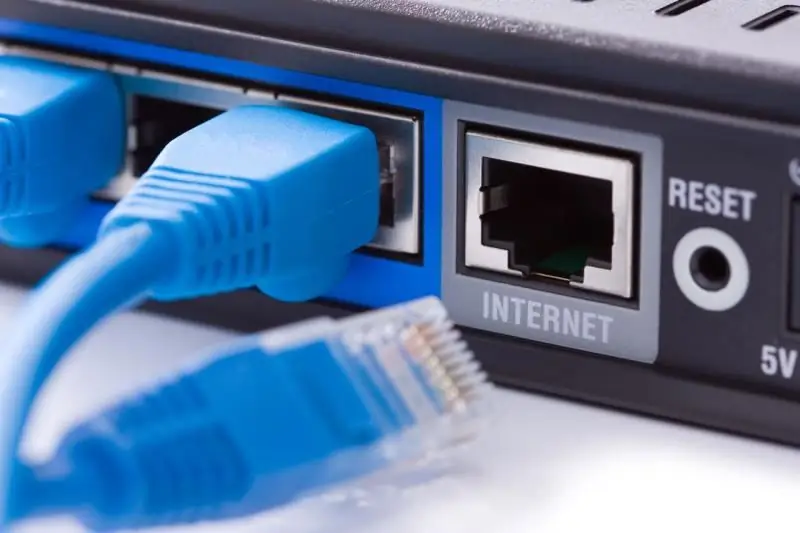
How to set up an Internet connection on a PC with Windows XP, 7, 8 and 10, as well as Linux and Ubuntu. Automatic internet connection when Windows starts
PPPOE Connection Protocol: What Is It, Setting Up A High-speed Connection For Windows 7, 10, Possible Errors
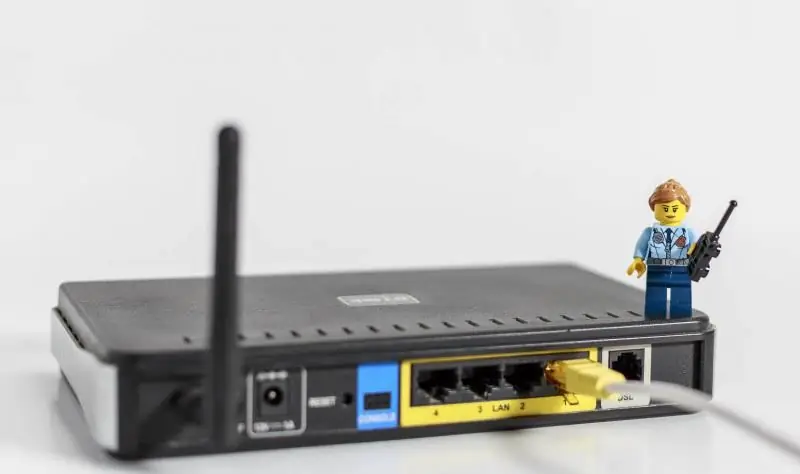
What is PPPoE protocol: pros and cons, principle of operation. How to configure this connection on Windows 7 and 10. What to do if an error appears
What To Do If An Error Appears In Google Chrome Your Connection Is Not Secure, How To Disable The Notification On Windows

Causes of the "Your connection is not secure" error. Ways to fix it: disable extensions, update, remove and install the browser
